The dIary of Anne Frank was one lesson which made most of us to cry in the classroom when we were in school and todayif she was alive, she would have turned 80. We used to imagine the girl who spent two years in a secret den writing a rearkable diary addressing kitty. And I had to literally go behind my hubby to download the movie Anne Frank 2-3 days ago.
Annelies Marie “Anne” Frank was born on June 12, 1929 in Frankfurt am Main in Weimar Germany to Otto Frank and Edith Frank-Holländer as the second daughter (Margot Frank was Anne’s elder sister) and lived most of her life in or near Amsterdam, in the Netherlands.
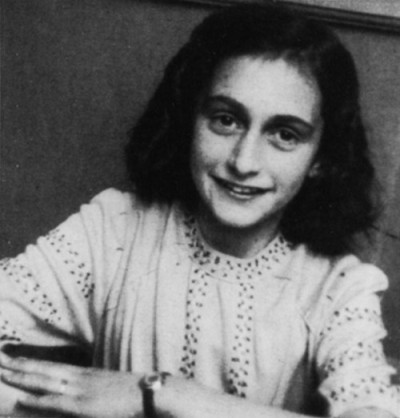
Anne Frank
Anne and her family moved to Amsterdam in 1933 after the Nazis gained power in Germany.
As persecutions against the Jewish population increased, the family went into hiding in July 1942 in hidden rooms in her father Otto Frank’s office building.

Anne and Margot, 1933While their parents were busy arranging the family's emigration to Holland, Anne and Margot spend the summer of 1933 with Grandmother Holländer in Aachen.
After two years, the group was betrayed and transported to concentration camps. Seven months after her arrest, Anne Frank died of typhus in the Bergen-Belsen concentration camp, within days of the death of her sister, Margot Frank.
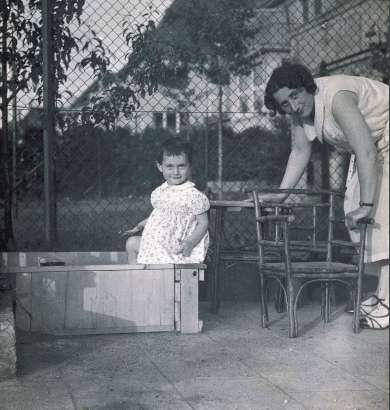
Anne in the SandboxAnne Frank and her mother in their yard on Marbachweg (Frankfurt), 1931.
Her father Otto, the only survivor of the group, returned to Amsterdam after the war to find that her diary had been saved, and his efforts led to its publication in 1947. It was translated from its original Dutch and first published in English in 1952 as The Diary of a Young Girl.
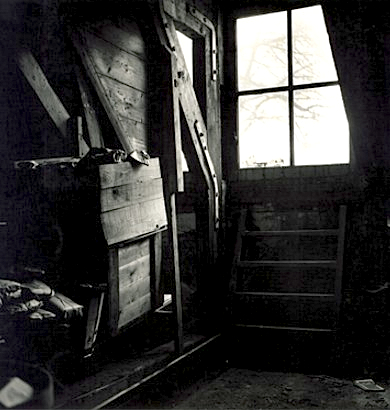
Anne’s Attic Window
The diary, which was given to Anne on her 13th birthday, chronicles her life from June 12, 1942 to August 1, 1944.
Anne Frank has been acknowledged for the quality of her writing, and has become one of the most renowned and most discussed victims of the Holocaust.
The Franks were liberal Jews and lived in an assimilated community of Jewish and non-Jewish citizens, where the children grew up with Catholic, Protestant, and Jewish friends. Edith Frank was the more devout parent, while Otto Frank, a decorated German officer from World War I, was interested in scholarly pursuits and had an extensive library.
On March 13, 1933, elections were held in Frankfurt for the municipal council and Adolf Hitler’s Nazi Party won. Anti-semitic demonstrations occurred almost immediately, and the Franks began to fear what would happen to them if they remained in Germany. Later that year, Edith and the children went to Aachen, where they stayed with Edith’s mother, Rosa Holländer. Otto Frank remained in Frankfurt, but after receiving an offer to start a company in Amsterdam, he moved there to organise the business and to arrange accommodation for his family.
Otto Frank began working at the Opekta Works, a company that sold the fruit extract pectin, and found an apartment on the Merwedeplein (Merwede Square) in Amsterdam.
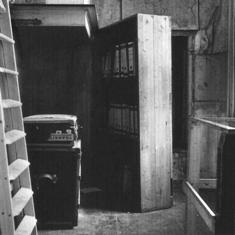
Bookcase hiding the Secret Annex
By February 1934, Margot was enrolled in a public school in Amsterdam and Anne in a Montessori school.
Margot demonstrated ability in arithmetic, and Anne showed aptitude for reading and writing. Her friend Hanneli Goslar later recalled that from early childhood, Anne frequently wrote, though she shielded her work with her hands and refused to discuss the content of her writing.
Margot and Anne had highly distinct personalities. Margot was well-mannered, reserved, and studious, while Anne was outspoken, energetic, and extroverted.
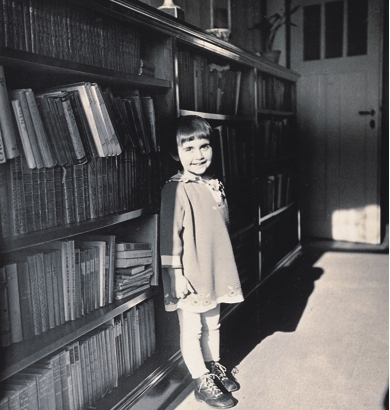
Margot in front of her parent's bookcase, March 1929
In 1938, Otto Frank started a second company Pectacon, which was a wholesaler of herbs, pickling salts and mixed spices, used in the production of sausages.
Hermann van Pels was employed by Pectacon as an advisor about spices. He was a Jewish butcher, who had fled Osnabrück in Germany with his family.
In 1939, Edith’s mother came to live with the Franks.
In May 1940, Germany invaded the Netherlands, and the occupation government began to persecute Jews by the implementation of restrictive and discriminatory laws; mandatory registration and segregation soon followed. Margot and Anne were excelling in their studies and had many friends, but with the introduction of a decree that Jewish children could attend only Jewish schools, they were enrolled at the Jewish Lyceum.
In April 1941, Otto Frank took action to prevent Pectacon from being confiscated as a Jewish-owned business. He transferred his shares in Pectacon to Johannes Kleiman, and resigned as director. The company was liquidated and all assets transferred to Gies and Company, headed by Jan Gies. In December 1941, he followed a similar process to save Opekta. The businesses continued with little obvious change and their survival allowed Otto Frank to earn a minimal income, but sufficient to provide for his family.
For her 13th birthday on June 12, 1942, Anne received a book she had shown her father in a shop window a few days earlier. Although it was an autograph book, bound with red-and-green plaid cloth and with a small lock on the front, Anne decided she would use it as a diary, and began writing in it almost immediately. While many of her early entries relate the mundane aspects of her life, she also discusses some of the changes that had taken place in the Netherlands since the German occupation.
In her entry dated June 20, 1942, she lists many of the restrictions that had been placed upon the lives of the Dutch Jewish population, and also notes her sorrow at the death of her grandmother earlier in the year.
Anne dreamed about becoming an actress. She loved watching movies, but the Dutch Jews were forbidden access to movie theaters from January 8, 1941.
In July 1942, Margot Frank received a call-up notice from the Zentralstelle für jüdische Auswanderung (Central Office for Jewish Emigration) ordering her to report for relocation to a work camp. Anne was told by her father that the family would go into hiding in rooms above and behind the company’s premises on the Prinsengracht, a street along one of Amsterdam’s canals, where some of Otto Frank’s most trusted employees would help them. The call-up notice forced them to relocate several weeks earlier than had been anticipated.
On July 6, 1942 morning, the family moved into the hiding place. Their apartment was left in a state of disarray to create the impression that they had left suddenly, and Otto Frank left a note that hinted they were going to Switzerland. The need for secrecy forced them to leave behind Anne’s cat, Moortje.
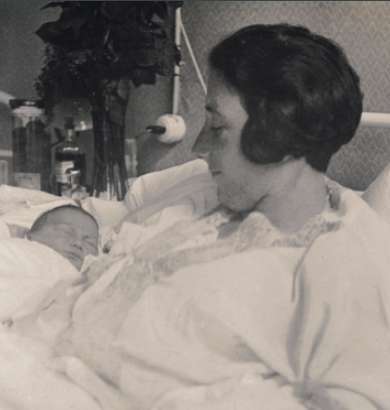
Baby Anne Edith Frank with Anne, a day after her birth.
As Jews were not allowed to use public transport, they walked several kilometers from their home, with each of them wearing several layers of clothing as they did not dare to be seen carrying luggage.
The Achterhuis (a Dutch word denoting the rear part of a house, translated as the “Secret Annexe” in English editions of the diary) was a three-story space entered from a landing above the Opekta offices. Two small rooms, with an adjoining bathroom and toilet, were on the first level, and above that a larger open room, with a small room beside it. From this smaller room, a ladder led to the attic. The door to the Achterhuis was later covered by a bookcase to ensure it remained undiscovered. The main building, situated a block from the Westerkerk, was non-descript, old and typical of buildings in the western quarters of Amsterdam.

Anne's room
Victor Kugler, Johannes Kleiman, Miep Gies, and Bep Voskuijl were the only employees who knew of the people in hiding, and with Gies’ husband Jan Gies and Voskuijl’s father Johannes Hendrik Voskuijl, were their “helpers” for the duration of their confinement. These contacts provided the only connection between the outside world and the occupants of the house, and they kept the occupants informed of war news and political developments. They catered for all of their needs, ensured their safety and supplied them with food, a task that grew more difficult with the passage of time. Anne wrote of their dedication and of their efforts to boost morale within the household during the most dangerous of times. All were aware that if caught they could face the death penalty for sheltering Jews.
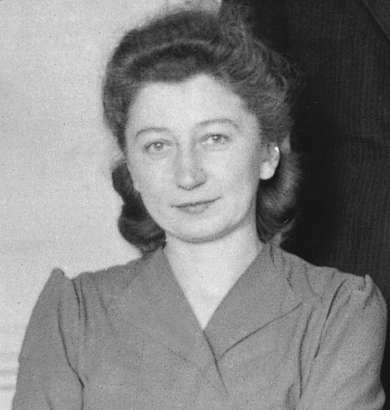
Miep Gies
On July 13, the Franks were joined by the van Pels family: Hermann, Auguste, and 16-year-old Peter, and then in November by Fritz Pfeffer, a dentist and friend of the family.
Anne wrote of her pleasure at having new people to talk to, but tensions quickly developed within the group forced to live in such confined conditions. After sharing her room with Pfeffer, she found him to be insufferable and resented his intrusion, and she clashed with Auguste van Pels, whom she regarded as foolish. She regarded Hermann van Pels and Fritz Pfeffer as selfish, particularly in regards to the amount of food they consumed.
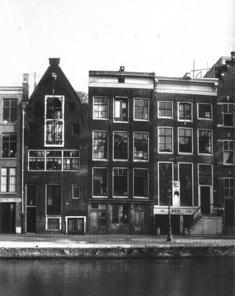
Frontal view of Anne's house in Amsterdam
Some time later, after first dismissing the shy and awkward Peter van Pels, she recognised a kinship with him and the two entered a romance. She received her first kiss from him, but her infatuation with him began to wane as she questioned whether her feelings for him were genuine, or resulted from their shared confinement.

Rear view of Anne's house in Amsterdam
Anne Frank formed a close bond with each of the helpers and Otto Frank later recalled that she had anticipated their daily visits with impatient enthusiasm. He observed that Anne’s closest friendship was with Bep Voskuijl, “the young typist… the two of them often stood whispering in the corner.”
In her writing, Anne Frank examined her relationships with the members of her family, and the strong differences in each of their personalities. She considered herself to be closest emotionally to her father, who later commented, “I got on better with Anne than with Margot, who was more attached to her mother. The reason for that may have been that Margot rarely showed her feelings and didn’t need as much support because she didn’t suffer from mood swings as much as Anne did.”

The Frank Family: Margot, Otto, Anne and Edith Frank on Merwedeplein in Amsterdam, 1941.
Anne and Margot formed a closer relationship than had existed before they went into hiding, although Anne sometimes expressed jealousy towards Margot, particularly when members of the household criticised Anne for lacking Margot’s gentle and placid nature.
As Anne began to mature, the sisters were able to confide in each other. In her entry of January 12, 1944, Anne wrote, “Margot’s much nicer… She’s not nearly so catty these days and is becoming a real friend. She no longer thinks of me as a little baby who doesn’t count.”
Anne frequently wrote of her difficult relationship with her mother, and of her ambivalence towards her. On November 7, 1942 she described her “contempt” for her mother and her inability to “confront her with her carelessness, her sarcasm and her hard-heartedness,” before concluding, “She’s not a mother to me.”
Later, as she revised her diary, Anne felt ashamed of her harsh attitude, writing: “Anne is it really you who mentioned hate, oh Anne, how could you?”
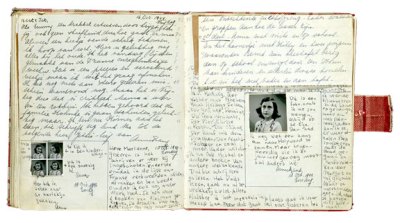
A page from Anne Frank's diary.
She came to understand that their differences resulted from misunderstandings that were as much her fault as her mother’s, and saw that she had added unnecessarily to her mother’s suffering. With this realisation, Anne began to treat her mother with a degree of tolerance and respect.
Margot and Anne hoped to return to school soon and continued with their studies while in hiding. Margot took a shorthand course by correspondence in Bep Voskuijl’s name and received high marks.
Most of Anne’s time was spent reading and studying, and she regularly wrote and edited her diary entries. In addition to providing a narrative of events as they occurred, she wrote about her feelings, beliefs and ambitions, subjects she felt she could not discuss with anyone. As her confidence in her writing grew, and as she began to mature, she wrote of more abstract subjects such as her belief in God, and how she defined human nature.
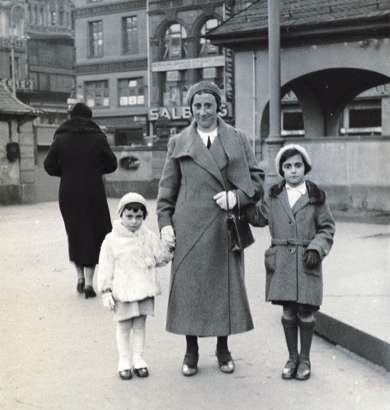
This photograph was taken in the centre of Frankfurt am Main on March 10, 1933. It is the last photograph Otto Frank takes before the family leaves Germany.
Anne aspired to become a journalist, writing in her diary on April 5, 1944: “ I finally realised that I must do my schoolwork to keep from being ignorant, to get on in life, to become a journalist, because that’s what I want! I know I can write …, but it remains to be seen whether I really have talent … And if I don’t have the talent to write books or newspaper articles, I can always write for myself. But I want to achieve more than that. I can’t imagine living like Mother, Mrs van Daan and all the women who go about their work and are then forgotten. I need to have something besides a husband and children to devote myself to! … I want to be useful or bring enjoyment to all people, even those I’ve never met. I want to go on living even after my death! And that’s why I’m so grateful to God for having given me this gift, which I can use to develop myself and to express all that’s inside me! When I write I can shake off all my cares. My sorrow disappears, my spirits are revived! But, and that’s a big question, will I ever be able to write something great, will I ever become a journalist or a writer?”
She continued writing regularly till her final entry of on August 1, 1944.
On August 4, 1944 morning, the Achterhuis was stormed by the German Security Police (Grüne Polizei) following a tip-off from an informer who was never identified. Led by Schutzstaffel Oberscharführer Karl Silberbauer of the Sicherheitsdienst, the group included at least three members of the Security Police. The Franks, van Pelses and Pfeffer were taken to the Gestapo headquarters where they were interrogated and held overnight.
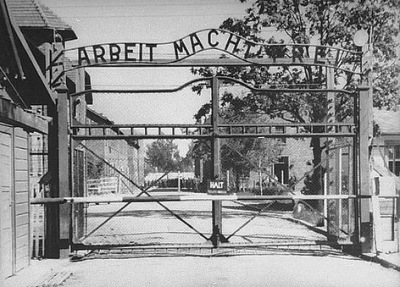
The front gate of Auschwitz-Birkenau concentration camp. The slogan Arbeit macht frei translates as “work will set you free”)
On August 5, they were transferred to the Huis van Bewaring (House of Detention), an overcrowded prison on the Weteringschans. Two days later, they were transported to Westerbork. Ostensibly a transit camp, by this time more than 1 lakh Jews had passed through it. Having been arrested in hiding, they were considered criminals and were sent to the Punishment Barracks for hard labour.
Victor Kugler and Johannes Kleiman were arrested and jailed at the penal camp for enemies of the regime at Amersfoort. Kleiman was released after seven weeks, but Kugler was held in various work camps until the end of war.
Miep Gies and Bep Voskuijl were questioned and threatened by the Security Police but were not detained. They returned to the Achterhuis the following day, and found Anne’s papers strewn on the floor. They collected them as well as several family photograph albums, and Gies resolved to return them to Anne after the war.
On August 7, 1944, Gies attempted to facilitate the release of the prisoners by confronting Silberbauer and offering him money to intervene, but he refused.
On September 3, the group was deported on what would be the last transport from Westerbork to the Auschwitz concentration camp, and arrived after a three-day journey. In the chaos that marked the unloading of the trains, the men were forcibly separated from the women and children, and Otto Frank was wrenched from his family.
Of the 1,019 passengers, 549, including all children younger than 15, were sent directly to the gas chambers. Anne had turned 15 and 3 months earlier and was one of the youngest people to be spared from her transport. She was soon made aware that most people were gassed upon arrival, and never learned that the entire group from the Achterhuis had survived this selection. She reasoned that her father, in his mid-50s and not particularly robust, had been killed immediately after they were separated.

Otto Frank
With the other females not selected for immediate death, Anne was forced to strip naked to be disinfected, had her head shaved and was tattooed with an identifying number on her arm. By day, the women were used as slave labour and Anne was forced to haul rocks and dig rolls of sod; by night, they were crammed into overcrowded barracks.
Witnesses later testified that Anne became withdrawn and tearful when she saw children being led to the gas chambers, though other witnesses reported that more often she displayed strength and courage, and that her gregarious and confident nature allowed her to obtain extra bread rations for Edith, Margot and herself.
Disease was rampant and before long, Anne’s skin became badly infected by scabies. She and Margot were moved into an infirmary, which was in a state of constant darkness, and infested with rats and mice.
Edith Frank stopped eating, saving every morsel of food for her daughters and passing her rations to them, through a hole she made at the bottom of the infirmary wall.
On October 28, selections began for women to be relocated to Bergen-Belsen. More than 8,000 women, including Anne and Margot Frank and Auguste van Pels, were transported, but Edith Frank was left behind and later died from starvation.
Tents were erected at Bergen-Belsen to accommodate the influx of prisoners, and as the population rose, the death toll due to disease increased rapidly. Anne was briefly reunited with two friends, Hanneli Goslar and Nanette Blitz, who were confined in another section of the camp. Goslar and Blitz both survived the war and later discussed the brief conversations that they had conducted with Anne through a fence. Blitz described her as bald, emaciated and shivering and Goslar noted that Auguste van Pels was with Anne and Margot Frank, and was caring for Margot, who was severely ill. Neither of them saw Margot as she was too weak to leave her bunk. Anne told both Blitz and Goslar that she believed her parents were dead, and for that reason did not wish to live any longer. Goslar later estimated that their meetings had taken place in late January or early February, 1945.
In March 1945, a typhus epidemic spread through the camp and killed about 17,000 prisoners.
Witnesses later testified that Margot fell from her bunk in her weakened state and was killed by the shock, and that a few days later Anne died. They stated that this occurred a few weeks before the camp was liberated by British troops on April 15, 1945, although the exact dates were not recorded.
After liberation, the camp was burned in an effort to prevent further spread of disease, and Anne and Margot were buried in a mass grave.

Grave
Otto Frank survived his internment in Auschwitz. After the war ended, he returned to Amsterdam where he was sheltered by Jan and Miep Gies, as he attempted to locate his family. He learned of the death of his wife Edith in Auschwitz, but remained hopeful that his daughters had survived.
After several weeks, he discovered that Margot and Anne also had died. He attempted to determine the fates of his daughters’ friends, and learned that many had been murdered.
Susanne Ledermann, often mentioned in Anne’s diary, had been gassed along with her parents, though her sister, Barbara, a close friend of Margot, had survived. Several of the Frank sisters’ school friends had survived, as had the extended families of both Otto and Edith Frank, as they had fled Germany during the mid 1930s, with individual family members settling in Switzerland, the United Kingdom and the United States.
Miep Gies gave Otto Frank the diary, along with a bundle of loose notes that she had saved, in the hope that she could have returned them to Anne.
Otto Frank later commented that he had not realised Anne had kept such an accurate and well-written record of their time in hiding. In his memoir he described the painful process of reading the diary, recognising the events described and recalling that he had already heard some of the more amusing episodes read aloud by his daughter.
He also noted that he saw for the first time the more private side of his daughter, and those sections of the diary she had not discussed with anyone, noting, “For me it was a revelation… I had no idea of the depth of her thoughts and feelings… She had kept all these feelings to herself”.
Moved by her repeated wish to be an author, he began to consider having it published. Her original notebook was supplemented by additional notebooks and loose-leaf sheets of paper. She created pseudonyms for the members of the household and the helpers. The van Pels family became Hermann, Petronella, and Peter van Daan, and Fritz Pfeffer became Albert Düssell. In this edited version, she also addressed each entry to “Kitty,” a fictional character in Cissy van Marxveldt’s Joop ter Heul novels that Anne enjoyed reading.
Otto Frank used her original diary, known as “Version A”, and her edited version, known as “Version B”, to produce the first version for publication. He removed certain passages, most notably those in which Anne is critical of her parents (especially her mother), and sections that discussed Anne’s growing sexuality. Although he restored the true identities of his own family, he retained all of the other pseudonyms.
Cornelis Suijk, former director of the Anne Frank Foundation and president of the U.S. Center for Holocaust Education Foundation, announced in 1999 that he was in the possession of five pages that had been removed by Otto Frank from the diary prior to publication; Suijk claimed that Otto Frank gave these pages to him shortly before his death in 1980. The missing diary entries contain critical remarks by Anne Frank about her parents’ strained marriage, and discusses Anne’s lack of affection for her mother.
